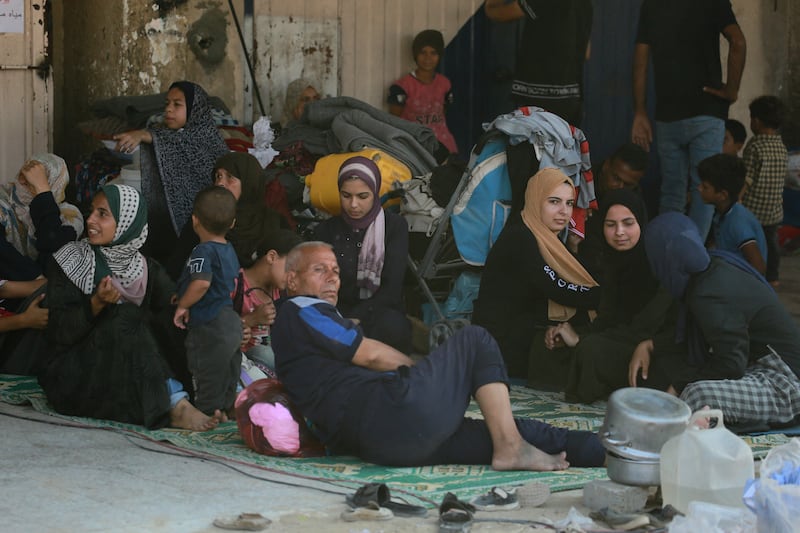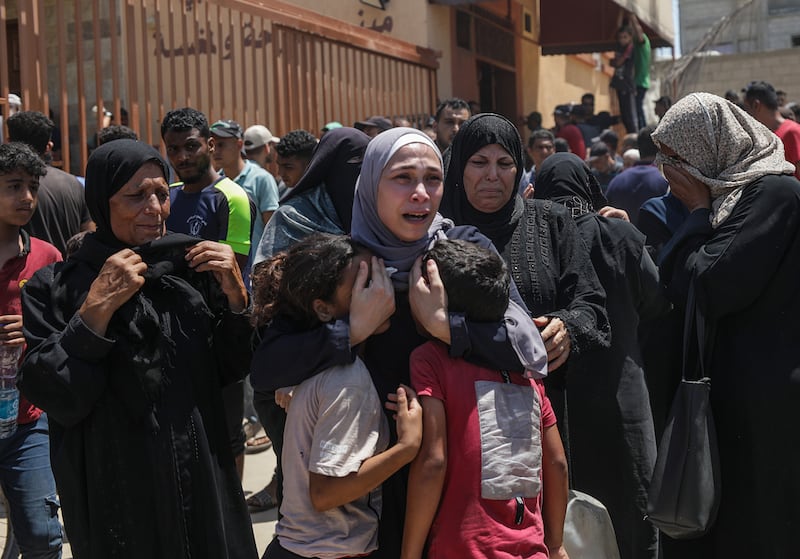Palestinian human rights researcher Mohammed Karekaa thought he was safe when he reached a UN shelter in the west of Gaza City on July 7th.
Israel had ordered the evacuation of several neighbourhoods for a military operation, forcing him and many others to leave with no time to grab any belongings and flee across the shattered city.
Yet within hours of arriving, they were back on the road, trudging through the rubble-filled streets in search of refuge because of Israeli raids around the shelter where the army had originally instructed them to go.
At one point, according to Karekaa, a military helicopter fired at the hungry and exhausted groups picking their way through the darkness.
“We were displaced twice in less than 10 hours,” he said. “We were starving and didn’t know where we were going. There aren’t even roads to walk on.”
Karekaa has since then been living on the streets of north Gaza, which has been reduced to a wasteland by the retaliatory offensive launched by Israel in response to the Hamas-led attack of October 7th. “Most houses and buildings here have been bombed,” he said. “There’s nowhere to live.”

Karekaa’s ordeal – the displacement, fear and hunger – are experiences shared by almost the entirety of Gaza’s population, trapped inside the coastal enclave during a ferocious war amid starvation conditions.
Some 1.9 million of the 2.3 million living in Gaza have been displaced, many of them multiple times, according to the UN.
As Israel has repeatedly issued evacuation orders during nine months of conflict, and sent back its warplanes and tanks to engage with Hamas fighters in districts it had already left, the Palestinian population has been left in a constant state of flux, reduced to destitute nomads lacking the basics of life.
Virtually all Gaza’s cities and towns have been devastated and emptied out as residents have been forced to move from area to area in search of safety. Israel on Monday ordered the evacuation of eastern parts of Al-Mawasi, the coastal strip in south Gaza that it had designated a safe or humanitarian zone for Palestinians fleeing areas of military activity.
The evacuation orders were first deployed on October 12th, five days after the Hamas-led attack on Israel that ignited the war.
In the months since, the Israeli military has repeatedly issued similar orders across the strip, including for Khan Younis, the biggest city in southern Gaza, and Rafah, where more than one million had sought sanctuary.
Rafah, on the Egypt border and once the main base of aid operations in the territory, has become a ghost town since Israeli forces entered in May, UN officials say. The city remains a war zone pounded by the military seeking to destroy the remaining Hamas battalions.
This month, after Israel issued fresh evacuation orders for Gaza City and some 250,000 people in Khan Younis and Rafah, the UN secretary-general António Guterres described the strip’s beleaguered population as being moved “like human pinballs across a landscape of destruction and death”.
Louise Wateridge, a spokeswoman for Unrwa, the main UN agency in the territory, said: “Gazans are being faced with bad decisions and bad choices in terms of do I stay here and just hope nothing happens, or do I move and risk safety along the way?
“They wonder if they should carve out a new space somewhere that’s already so overcrowded and with no services?”
Al-Mawasi has been the destination for most evacuees who have flooded into the now heavily congested 14sq km strip that has no infrastructure or services.
The chaotic and ever-expanding encampment is now packed with makeshift shelters made of plastic sheets. There is limited access to toilet facilities or drinking water, while piles of rubbish rot in the soaring summer heat.
The UN has estimated up to 1.5 million people are now living there, and that fewer than 300,000 Gazans remain in the north of the strip, with the rest scattered across the middle region.
And yet despite Al-Mawasi’s designation as a safe zone, Israeli strikes have killed people sheltering there. Some 90 Palestinians died this month when Israeli forces targeting a senior Hamas leader hit nearby tents in the area.

Mohamed Hamdouna and his family of 11 have also been displaced multiple times. Early in the war, they moved first from north to central Gaza, then to Rafah, in response to various evacuation orders. When in Rafah, “it took a miracle”, he said, to buy a tent that they set up on a street near a hospital.
Five months later, when they were told to move again after Israel launched its Rafah ground offensive and ordered the city to be evacuated, the Hamdouna family had run out of money.
So they spent three days under bombardment sleeping outside a UN school until they could cobble together the Shk400 (€100) needed to hire a donkey cart to move the women and children in the direction of Khan Younis, while the men travelled on foot.
But when they reached their destination, they realised the area was already full. Hamdouna said he and some others broke into a fenced-off plot of land and pitched their tents there instead.
Life for them and everyone else remains intolerable. “There is rubble and destruction everywhere,” he said. “The streets are drowning in sewage which has polluted the water wells.”
Despite the widespread destruction of the mostly abandoned cities, some people have chosen to return to their wrecked houses, and a minority have not left their areas at all, ignoring evacuation orders.
“We run from district to district and from house to house, like we are playing a cat-and-mouse game,” said Rana Mohamed, a mother of four who decided with her husband to remain in the north when the war started, because they did not expect it to last long.
The family has moved six times in Gaza City and its surroundings, mostly on foot because donkey carts are often hard to find.
“We are stunned every time we walk on the streets,” she said. “There is no more Gaza City or [nearby] Jabalia. We don’t recognise the streets and all features have disappeared. We were lost several times when trying to walk to the city centre.”
Wateridge, the Unrwa spokeswoman, said some families in Al-Mawasi had chosen to go back to shattered houses because of harsh conditions in the makeshift shelters and because safety is not guaranteed anywhere.
“People really don’t want to live in these makeshift shelters,” she said, noting how they were insufferable in the heat, alongside the presence of rats and the threat from disease.
“Some people would rather live in bombed-out buildings because they’ve got either more space or it’s not as hot,” she added. “These are the kinds of options that people now have left.” – Copyright The Financial Times Limited 2024
- Sign up for push alerts and have the best news, analysis and comment delivered directly to your phone
- Find The Irish Times on WhatsApp and stay up to date
- Our In The News podcast is now published daily – Find the latest episode here






















